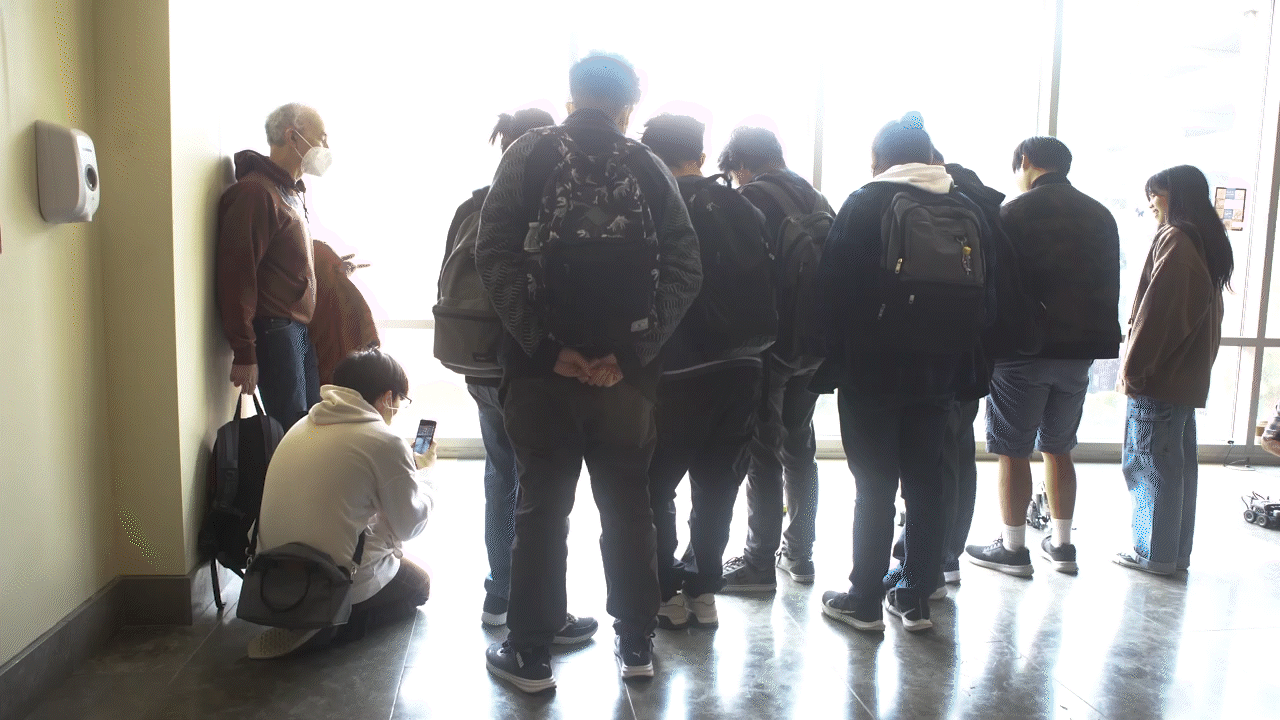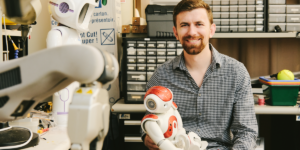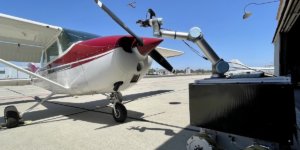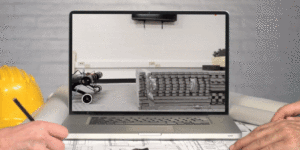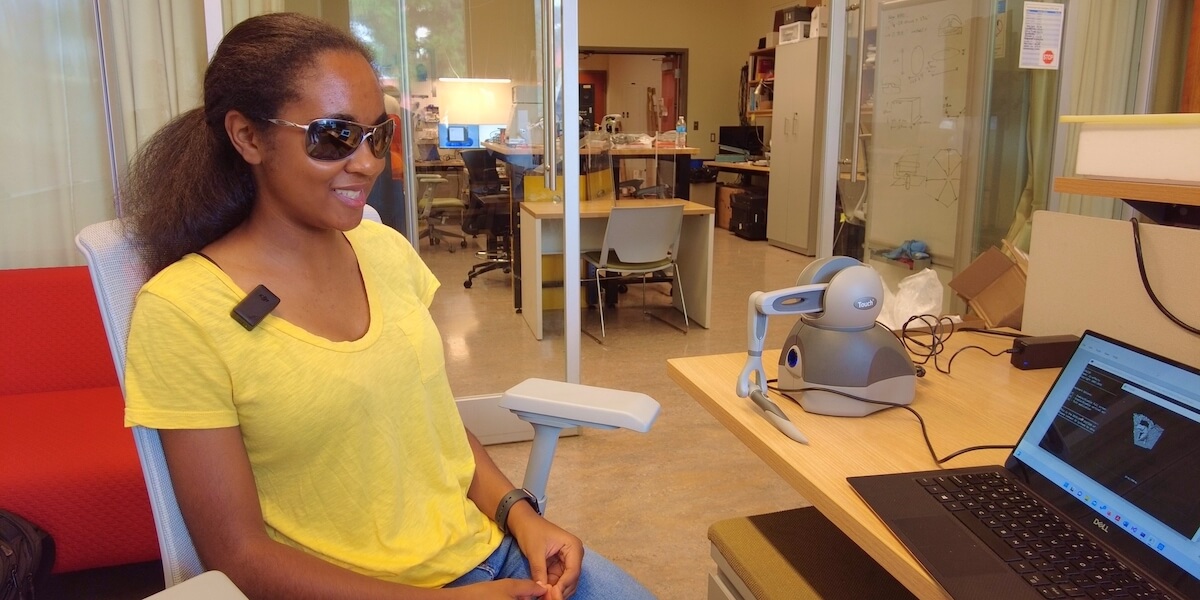
Haylee Mota, a sophomore mechanical engineering major at USC Viterbi
Haylee Mota remembers the moment well. She was a curious and inquisitive 7-year-old in awe of the spaceships, rockets and fighter jets at the National Air and Space Museum in Washington D.C., when she made up her mind that one day she would become an engineer.
However, the pathway to making that dream a reality involved a learning curve far beyond academics. The 19-year-old has not been able to see a rocket or a textbook since she was a child. Mota is blind, but she’s never lost sight of that childhood dream – in fact, she’s well on her way to making it a reality.
LEBER CONGENITAL AMAUROSIS
“I was born with Leber Congenital Amaurosis,” Mota said. “The doctors didn’t notice at first. I was a few months old when my mom noticed that I would go past the TV and not pay any attention to it. She began to question if there was something wrong with my eyes.”
Leber Congenital Amaurosis is a rare genetic eye disorder that causes light-gathering cells in the retina not to function properly. The disorder is also degenerative, causing Mota’s vision loss to become more severe over time. Now she can only see shadows and light perception. While blindness is often presented as a completely incapacitating disability, Mota has not let it slow her down.
“You only live once, so don’t let anything hold you back,” is her motto.
“You only live once, so don’t let anything hold you back,” is her motto.
In the fall of 2021 with her guide dog “Nicky,” a 5-year-old golden retriever, by her side, the Rhode Island native decided to attend the USC Viterbi School of Engineering, thousands of miles away from her home and her family. Like any other first-year student new on campus, there was a lot to learn, but life away from home involved extra challenges and more determination for Mota.
ENGINEERING A SOLUTION
Taught by Professor Paul Ronney, chair of the USC Viterbi Department of Aerospace and Mechanical Engineering, AME 101, Introduction to Mechanical Engineering and Graphics, was one of the first classes Mota enrolled in as a freshman at USC Viterbi. AME 101 requires students to participate in a variety of visual and hands-on activities like using a soldering iron or building a structurally sound 3D-printed bridge with pieces of wood – challenges Mota was ready to tackle head-on. She reached out to Ronney in an email before classes started.
“When she first reached out to me, my immediate reaction was: ‘How am I going to do this?’ and then my second reaction was, “This is cool, this will be a new challenge for me,” Ronney explained. “I was concerned about the hands-on part, but I didn’t want her to have a watered-down experience. I told her I expect all the students that we train to learn to use a band saw, a drill, a belt sander, and to solder. I was expecting her to say, ‘How can I do that?’ At which point she said, ‘Well, I have done all of those except solder.’”
After researching and seeking guidance from other professors across the country, Ronney realized that many programs designed for STEM students, like CAD (computer-aided design), were not accessible to the visually impaired. Just as the field of engineering itself requires an open mind and creative thinking to solve a challenge, Ronney and Mota worked together to find solutions.
Whether it was physically etching graphs onto acrylic so that Mota could feel the points, guiding her hands to teach her how to solder, or 3-D printing parts for her to touch and measure for a CAD assignment project, Ronney says he was impressed at how quickly Mota learned and adapted. He says by the end of the fall semester Mota was thriving in AME 101, and the two stayed connected the following semester.
“He told me I want to keep in touch with you because I want you to get the full engineering experience here at USC Viterbi,” said Mota. “I reached out to Professor Ronney in the spring to tell him that I was looking for an internship opportunity for the summer so if you have anything can you please tell me about it. He then put me in touch with Professor Gupta.”
TELEPRESENCE ROBOTS
Satyandra K. Gupta, who holds the Smith International Professorship in Mechanical Engineering, encouraged Mota to apply to the 2022 Research Experiences for Undergraduates (REU) program, which is supported by a grant from the National Science Foundation. Gupta participates in the 10-week summer research program for undergraduates hosted at USC each year, giving 10 students from across the country the opportunity to work in state-of-the-art labs with USC faculty to research robotics and autonomous systems. Mota was selected to participate in the program and chose to work in Gupta’s lab where she found his robotics research on assistive technology to be of particular interest.
“I have always been interested in assistive technologies and seeing how they can help people with different disabilities,” said Gupta, who has a daughter with autism. “I understand the challenges that people with disabilities face. I certainly have a desire to figure out ways that technology can play a role in helping people.”
For the summer program, Mota decided to focus her research on making telepresence robots accessible for people who are visually impaired. As employers around the world allow more flexible and remote schedules, telepresence robots have increased in popularity during the pandemic – offering users the ability to appear in locations where they can’t be in person. Think of telepresence robots as video conference technology on wheels. The user’s face appears on the robot’s screen and a camera on the robot allows the user at home to select a point in the room for the robot to then navigate to autonomously.
Because it requires a user to see the room on a screen to navigate around, telepresence robots are inaccessible for people who are visually impaired.
“Unfortunately, the way the entire telepresence industry is configured, it’s not being designed for people who are visually impaired,” said Gupta. “The way you drive the robot is by looking at your screen, and the way the robot gives you information is entirely through visual signals.”
Through Mota’s research, she found that by changing the telepresence robot’s navigational system to rely on touch instead of vision, the robot became more accessible.
“I took a haptic device, and I sent that device an image of the room that the robot was located in, the user is then able to feel all the objects in the room,” Mota explained. “Once you’ve felt all the objects, you can then determine where you want the robot to navigate, and then you can press a button and send the robot to that point.”
The haptics device maps out rooms and objects using points to create an image. Once the image is rendered, the user can then pick up a stylus to navigate around the room allowing them to feel if there is an object, like a table, located in the corner.
LIFE OUTSIDE THE CLASSROOM
Mota now plans to further her interest and research in haptics technology. This fall, she began working in the Haptics Robotics and Virtual Interaction (HaRVI) Laboratory on campus, run by Heather Culbertson, a Gabilan Assistant Professor of Computer Science and Aerospace and Mechanical Engineering.
As her journey to becoming an engineer continues, Mota’s childhood love of rockets and spaceships continues to drive her forward. This past summer, she was able to tour NASA’s Jet Propulsion Laboratory (JPL) in Pasadena through the REU Program. Now a sophomore at USC Viterbi, Mota plans to work in the field of propulsion and fluid dynamics once she graduates.
Outside of just being fascinated by the aerodynamics of rockets and planes. Mota decided to put her own aerodynamics to the test after trying skydiving over the summer. Outside of her love of engineering, Mota is a music lover who plays piano and guitar and appreciates jazz for its improvisation.
When I met Haylee at her haptics lab in Ronald Tutor Hall for this interview, Mota informed me that she was planning to learn how to skateboard with a friend after our interview. It is easy to say that Haylee Mota is fearless, but what I found out is that also she is determined not to take no for an answer.
“People think you can’t do certain things because of your disability and that just annoys me,” Mota explained. “I’m stubborn, and I don’t like to be told what to do or what I can’t do by other people.”
Published on September 29th, 2022
Last updated on September 29th, 2022




